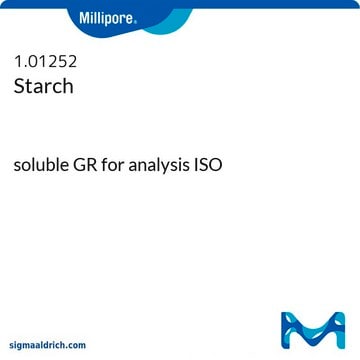The amylose to amylopectin ratio is not determined for this product. However, numerous literature references suggest corn starch has a range of 25 - 28% amylose to 72 - 75% amylopectin. Please see the link below to review an example:
https://pmc.ncbi.nlm.nih.gov/articles/PMC8747220/
Kluczowe dokumenty
S9679
Starch from corn
Synonim(y):
Corn starch, Starch from maize
Wybierz wielkość
455,00 zł
Wybierz wielkość
About This Item
455,00 zł
Polecane produkty
pochodzenie biologiczne
corn
Poziom jakości
Formularz
solid
kolor
white
przydatny zakres pH
4.0 -7.0
temp. przechowywania
room temp
Szukasz podobnych produktów? Odwiedź Przewodnik dotyczący porównywania produktów
Opis ogólny
Zastosowanie
Działania biochem./fizjol.
Inne uwagi
Kod klasy składowania
11 - Combustible Solids
Klasa zagrożenia wodnego (WGK)
nwg
Temperatura zapłonu (°F)
Not applicable
Temperatura zapłonu (°C)
Not applicable
Środki ochrony indywidualnej
Eyeshields, Gloves, type N95 (US)
Wybierz jedną z najnowszych wersji:
Certyfikaty analizy (CoA)
Nie widzisz odpowiedniej wersji?
Jeśli potrzebujesz konkretnej wersji, możesz wyszukać konkretny certyfikat według numeru partii lub serii.
Masz już ten produkt?
Dokumenty związane z niedawno zakupionymi produktami zostały zamieszczone w Bibliotece dokumentów.
Klienci oglądali również te produkty
-
What is the percentage of amylose and amylopectin?
1 answer-
Helpful?
-
Active Filters
Nasz zespół naukowców ma doświadczenie we wszystkich obszarach badań, w tym w naukach przyrodniczych, materiałoznawstwie, syntezie chemicznej, chromatografii, analityce i wielu innych dziedzinach.
Skontaktuj się z zespołem ds. pomocy technicznej


